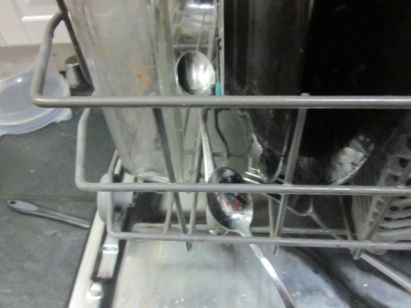There are some household jobs that I just can’t do with a baby in the room. Cleaning the toilet, for example. Loading and unloading the dishwasher has been on the list as well; my babies typically try to climb up on the open door and get inside. Sometimes, though, I just have to get it done. Yesterday was one of those times.
So there I was, loading the dishwasher, and there R was, trying to get inside it. After saying “no” and pulling her out of the appliance several times, I decided to see whether she could be redirected to a more productive task.
“R,” I said, “do you want to help me load the dishwasher?”
“Dah!” She chirped. (No, we don’t speak Russian at home. “Dah!” is the R version of “Yeah!”)
I took some of the dirty spoons from the sink and placed them on the open dishwasher door. “Look,” I said, and picked up a single spoon and placed it in the cutlery basket. “Can you put the spoons into the basket?”
“Dah!”
We worked side-by-side for a few minutes. Actually, R worked. I kept stealing glances at her and marveling at her focus and concentration. It always amazes me, this capacity for focused work that even a one-year-old has. I continued to pass her the cutlery (minus the sharp knives, of course) and she continued to work.
Lest this sound like more sanctiMommyous bragging, I made sure to take a “reality check” picture. Yes, R worked diligently, but look where the cutlery ended up:
I had to place the cutlery in the basket after R finished her work, so clearly the point of the exercise wasn’t for her to lighten my load by helping with the cutlery. No, useful child labour doesn’t kick in until roughly age four. The point is that as a parent I often have two choices – admonish the child for misbehaviour or channel their interest into purposeful work – and this time I chose the latter. The result? Ten quiet, peaceful, purposeful minutes with my baby, and a baby who already knows the satisfaction of being a contributing member of the family.



